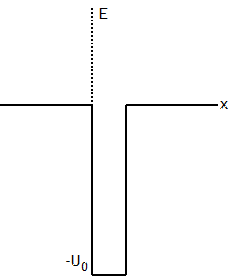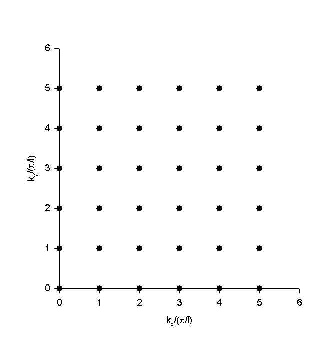Fermi's golden rule
Problem:
Consider spinless non-relativistic free particles of mass M
moving in a two dimensional square box. Find an expression for the density of
states ρ(E).
Remember ρ(E)dE is
defined as the number of energy levels per unit volume between E and E + dE.
Solution:
Problem:
Consider a particle in the ground state of a one-dimensional square well of
with a and depth U0.
Assume that the well is very deep and
k/k0 = (2m(E + U0)/(2mU0))½ << 1
for the ground state, so that the ground state wave function is nearly identical
to that of the infinite square well.
At t = 0, a time dependent perturbation W(t) = Wcosωt
is turned on.
(a) What is the minimum frequency necessary to free the particle
from the well?
(b) For frequencies greater than this minimum frequency, use
perturbation theory to find the transition rate.
You can assume that the free particles will be in a box of size L >> a.

Solution:
- Concepts:
Fermi's golden rule, the infinite square well
- Reasoning:
The initial wave function of the particle look very much like the
wave function of a particle in an infinite square well. The final state
of the particle is a continuum state.
- Details of the calculation:
(a)
Let H0 be the Hamiltonian of the infinite square well.
Eigenfunctions of H0: Φn(x) = (2/a)½sin(nπx/a)
with eigenvalues En = n2π2ħ2/(2ma2).
The ground state energy is E1 = π2ħ2/(2ma2).
In a very deep well the ground state energy is approximately equal to -U0
+ E1 ~ -U0.
The minimum frequency required to free the particle from the well therefore is
ωmin = U0/ħ.
(b)
To find the transition rate we use Fermi's golden rule.
If W(t) = Wcos(ωt), then the transition probability per unit time is given by
w(i,E) = (π/(2ħ))ρ(E)|WEi|2δE-Ei,ħω, where WEi
= <ΦE|W|Φi>.
Assume that the ejected
particle is a free particle confined to a region of
width L >> a. Use periodic boundary conditions. Then
Φk(x) = L-½exp(ikx), with k = 2πn/L, n = 0, ±1, ±2, ...
. k2 = 2mE/ħ2 = 2m(ω - ωmin)/ħ.
The number of states with wave vectors whose magnitudes lie between k and k + dk
is
dN = 2 dk/(2π/L) = Ldk/π. (The particle can move towards the left or to the
right.)
dN/dk = L/π.
The density of states is dN/dE = (dN/dk)(dk/dE).
With E = ħ2k2/(2m) we have ρ(E) = dN/dE = Lm/(πkħ2).
WEi = (2/La)½W∫0adx eikxsin(πx/a)
= (2/La)½W(eika+1)πa/(π2 - k2a2).
|WEi| = W2(2/La)cos2(ka/2)4π2a2/(π2 - k2a2)2.
w(i,E) = (π/(2ħ))Lm/(πkħ2)W2(2/La)cos2(ka/2)4π2a2/(π2
- k2a2)2
= W2cos2(ka/2)4π2am/[kħ3(π2
- k2a2)2].
This is the transition probability per unit time.
Problem:
A hypothetical particle of mass 2m can decay into two different final states
under the action of a perturbation H'.
(a) 2 m --> m + γ,
(b) 2 m --> 1.5 m + γ.
Here m and 1.5 m represent particles of mass m and 1.5 m respectively. If the
matrix elements of H' are equal, i.e. <2 m|H'|m> = <2 m|H'|1.5 m>, what
will be the relative likelihood of decay to m as opposed to 1.5 m? You may
assume the recoil fragment (m or 1.5 m) receives negligible kinetic energy.
Solution:
- Concepts:
Fermi's golden rule,
- Reasoning:
The transition probability per unit time is
w(i,βE)
= (2π/ħ)ρ(β,E)|WEi|2δE-Ei,ħω;
ρ(β,E)dE
is the number of final states in the interval dE characterized by some discrete
index b.
Here ρ(β,E)
is the density of photon states for photons of energy ħω
= (minitial - mfinal)c2.
- Details of the calculation:
The number of photon states ρ(β,E)dΩdE,
i.e. the number of photon states in an energy interval between E and E + dE
with wave vector k in the solid angle dΩ
is proportional to d3k.
ρ(E)dΩdE
∝ d3k
∝ p2dpdΩ.
Therefore ρ(E) ∝
p2dp/dE.
p = E/c, ρ(E) ∝ E2/c3
∝ ω2/c3.
So if the matrix elements are equal, the likelihood of decay is proportional
to (minitial - mfinal)2.
P(a)/P(b) = (m/0.5 m)2 = 4.
Problem:
A uniform periodic electric field acts upon a hydrogen atom, which at
t = 0 is in its ground state. Determine the minimum frequency of
the field necessary to ionize the atom and use perturbation theory to evaluate
the probability for ionization per unit time. For the sake of simplicity,
assume the electron in the final state to be free.
Solution:
- Concepts:
Time dependent perturbation
theory, Fermi's golden rule
- Reasoning:
Fermi's golden rule gives the probability per unit time for a transition
from a state of the discrete spectrum to a state corresponding to an
infinitesimal interval in the continuous spectrum.
- Details of the calculation:
w(i,βE)
= (π/2ħ)ρ(β,E)|WEi|2dE-Ei,ħω
for W(t) = Wcos(ωt).
ρ(β,E)dE
is the number of final states in the interval dE characterized by some
discrete index β.
Here W(t) = WDE = er∙E =
eE0zcos(ωt).
The minimum frequency necessary to ionize the hydrogen is
ω0 = EI/ħ
= μe4/(2ħ3).
Assume the ejected electron is free.
The eigenfunctions and
eigenvalues of a free electron confined to a cubical 3D infinite square well
with periodic boundary conditions are
ψnml(x,y,z)
= (1/L)3/2exp(ik∙r)= (1/L)3/2exp(ikxx)exp(ikyy)exp(ikzz),
with kx = 2πn/L, ky =
2πq/L, kz = 2πl/L,
n, q, l = ±1, ±2, ... .
The associated eigenvalues are
Enql = (n2 + q2 + l2)4π2ħ2/(2mL2)
= (kx2 + ky2 + kz2)ħ2/(2m)
= ħ2k2/(2m).
[H = px2/(2m) + py2/(2m)
+ pz2/(2m), if x, y , z < L.
ψ(x,y,z)
= Φ(x)χ(y)γ(z).
(-ħ2/(2m))(∂2/∂x2)Φ(x)
= ExΦ(x).
Φ(x) = (1/L)½exp(ikxx),
Φ(x) = Φ(x + L) --> kx = 2πn/L.
Ex = ħ2kx2/(2m)
= 4π2n2ħ2/(2mL2)
.]
Δkx = Δky
= Δkz = 2π/L.

To each allowed knml
there corresponds a wave function ψnml(x,y,z).
The tips of the vectors
knml divide k-space into elementary cubes of edge length 2π/L.
We have one vector per (2π/L)3 volume
of k-space.
The number of vectors in a volume d3k of k-space therefore is dN =
d3k/(2π/L)3.
d3k = k2dkdΩ,
dN = k2dkdΩ/(2π/L)3
= k2dkVdΩ/(2π)3
= number of state with a wave vector of magnitude between k and k + dk in a
solid angle dΩ.
dN/dk = k2dΩ/(2π/L)3
= k2VdΩ/(2π)3.
(V = L3.)
The density of states for the electron is dN/dE = (dN/dk)(dk/dE), with E =
ħ2k2/(2m).
dN/dE = ρ(β,E)
= 2½m3/2VE½dΩ/(2πħ)3.
(We do not multiply by 2 since the interaction cannot flip the spin.)
The ground state wave function of hydrogen is (πa02)-½exp(-r/a0).
We therefore have WE1 = (Vπa02)-½∫exp(-ik∙r-r/a0)(-er∙E)d3r.
To evaluate this integral let
k point into the z-direction and use
spherical coordinates.
r =
r(r,θ,φ),
E = E(r0,θ0,φ0).
Then
E∙r = E0r[cosθcosθ0
+ sinθsinθ0cos(φ-φ0)]
and
WE1 = -(Vπa02)-½eE0∫∫∫exp(-ik∙r-r/a0)[cosθcosθ0
+ sinθsinθ0cos(φ-φ0)]r3drsinθdθdφ
= 2πcosθ0(Vπa02)-½eE0∫-11dcosθ[∫0∞exp(-ikrcosθ
- r/a0)r3dr]cosθ.
WE1 = -2πcosθ0(Vπa02)-½eE0∫-11dx
(3! x)/(a0-1 + ikx)4 = -i2πcosθ0(Vπa02)-½eE0
16ka05/(1 + k2a02)3.
Notation:
We have EI = ħω0
= μe4/(2ħ2),
a0 = ħ2/(me2),
so we may write a02 = ħ4/(m2e4)
= ħ/(2mω0).
Energy conservation requires that E = ħω - ħω0.
Therefore k2 = 2mE/ħ2 =
2m(ω - ω0)/ħ,
k2a02 = (ω - ω0)/ω0,
1 + k2a02 = ω/ω0.
The probability that an electron is ejected into a solid angle dΩ
with energy E per unit time therefore is
w(1,dΩ
E) = ( π/2ħ)2½m3/2VE½dΩ/(2πħ))3|-i2πcosθ0(Vπa02)-½eE0
16ka05/(ω/ω0)3|2
= E02(cosθ0)2(ω/ω0)6[(ω
- ω0)/ω0]3/2a03dΩ
28/(4πħ).
To find the probability per unit time that an electron is ejected with
energy E we must integrate over all possible angles between the direction of
the field and the direction of k.
∫02π∫-11(cosθ0)2dcosθ0dφ0
= 4π/3.
w(1,dΩ
E) = (256/3)(a03/ħ)
E02(ω/ω0)6[(ω
- ω0)/ω0]3/2.
Near the threshold for ionization the probability increases from zero as (ω
- ω0)3/2. If
ω
>> ω0 it decreases as ω-9/2. It has a maximum for
ω = 4ω0/3.
Problem:
Nuclei sometimes
decay from excited states to the ground state by internal conversion, a
process in which an atomic electron is emitted instead of a
photon. Let the initial and final nuclear states have wave
functions Ψi(r1,r2,..,rz)
and Ψf(r1,r2,..,rz),
respectively,
where ri describes the protons.
The perturbation giving rise to the transition is the proton-electron
interaction,
W = -∑i=1z e2/|r -
ri|,
where r is the electron coordinate.
(a) Write
down the matrix element for the process in lowest-order perturbation
theory, assuming that the electron is initially in a state characterized
by the quantum numbers nlm, and that its energy, after it has
been emitted, is large enough so that its final state may be described
by a plane wave. Neglect spin.
(b) Write
down an expression for the internal conversion rate.
(c) For
light nuclei, the nuclear radius is much smaller than the Bohr radius
for the given Z, and we can use the expansion
1/|r - ri| ≈ 1/r +
r∙ri/r3.
Use this
approximation to express the transition rate in terms of the dipole
matrix element
d = <Ψf|∑i=1z
ri|Ψi>.
Solution:
- Concepts:
Fermi's golden rule, a constant perturbation
- Reasoning:
We find the internal conversion rate using Fermi's golden rule,
w(0-->1) = (2π/ħ)ρ(E)|W10|2δE1,E0,
because the final state of the electron is a continuum state.
- Details of the calculation:
(a) The initial state is Φ0
= ψlmn(r)Ψi(r1,r2,..,rz),
the final state is Φ1
= V-½ exp(ik∙r) Ψf(r1,r2,..,rz).
The final state of the electron is a plane wave. We confine the plane
wave to a volume V = L3 and use periodic boundary
conditions. The matrix element needed to calculate the internal
conversion rate is
<Φ1|W|Φ0>
= V-½ ∫d3r
exp(ik∙r)<Ψf(ri)|∑ie2/|r-ri||Ψi(ri)>ψlmn(r).
The energy eigenstates of an electron confined to a cubical box with
periodic boundary conditions are
Φnx,ny,nz(x,y,z) = L-3exp(i2π(nxx+nyy+nzz)/L),
with nx, ny, nz = 0, ±1, ±2, ... .
We have kx = 2πnx/L,
ky = 2πny/L, kz
= 2πnz/L.
If k is large, then the number of states with wave vectors whose magnitudes
lie between k and k + dk is
dN = 4πk2dk/(2π/L)3
= 4πVk2dk/(2π)3.
dN/dk = 4πVk2/(2π)3.
The density of states is dN/dE = (dN/dk)(dk/dE).
With E = ħ2k2/(2m) we
have dN/dE = 2mVk/(4π2ħ2)
= (2m)3/2VE½/(4π2ħ3).
We are instructed to neglect spin. If we do not neglect spin we
multiply the density by 2.
We therefore have for the internal conversion rate
w(0-->1)
= (½πħ)(2m/ħ2)3/2E½|∫d3r
exp(ik∙r)<Ψf|∑ie2/|r-ri||Ψi>ψlmn(r)|2δ(E1
- E0),
(c) We use
1/|r - ri| ≈ 1/r +
r∙ri/r3.
<Ψf|∑ie2/|r-ri||Ψi>
= (e2/r3)r∙<Ψf|∑ri||Ψi>
= (e2/r3)r∙d, since
Ψi
and Ψf
depend only on the nuclear coordinates ri and not on the
electron coordinate r.
d is independent of
r. We can therefore write
w(0-->1)
= (e4/2πħ)(2m/ħ2)3/2E½|d∙∫d3r
exp(ik∙r) (r/r3)
ψlmn(r)|2δE1,E0,


